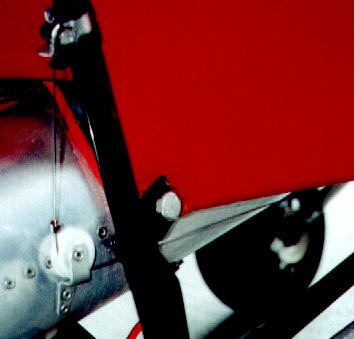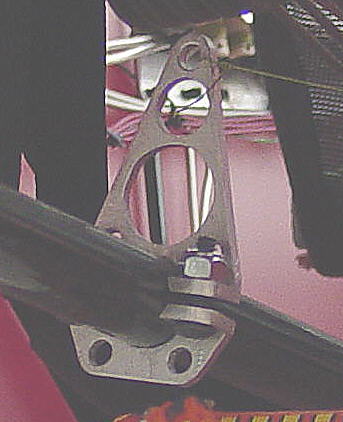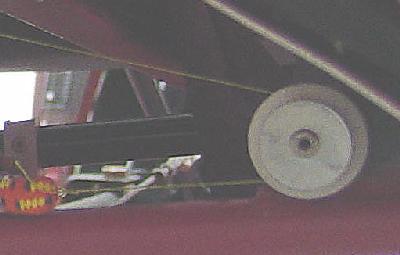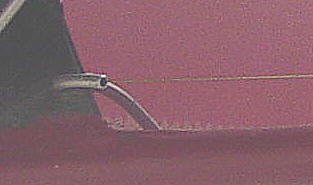|
|
 A small hose clamp secures a bracket to the aileron push-pull tube. A bicycle shifter cable is fed down through a pulley and under the rear of the fuselage cage. The other end of the cable is connected to a loop so that small bungee cords can be connected to the loop and around a cage cross member. The number of bungee cords is increased until the plane will fly well hands-off at cruise speed.
A small hose clamp secures a bracket to the aileron push-pull tube. A bicycle shifter cable is fed down through a pulley and under the rear of the fuselage cage. The other end of the cable is connected to a loop so that small bungee cords can be connected to the loop and around a cage cross member. The number of bungee cords is increased until the plane will fly well hands-off at cruise speed.
|
|
|

|
 The actuation/crank arm was made from 1/8 inch thick aluminum angle. It is attached to the aileron control torque tube just in front of the guide pulleys for the rudder and elevator cables.
The actuation/crank arm was made from 1/8 inch thick aluminum angle. It is attached to the aileron control torque tube just in front of the guide pulleys for the rudder and elevator cables.
The arm length is determined by the distance between the top of the torque tube and cable clearance with the flaperons fully deployed. Fifty pound woven fish line is passed through and tied to the upper hole and is used to supply a bias force to the crank arm. |
 A pulley is pop riveted to the right side web that is located between the lower cage cross member and the landing gear leg socket tube. The fish line from the crank arm passes over the pulley and is tied through a loop in the bungee cord. The length of fish line is determined by full left stick position and tying the cord so that the bungee cord does not run up onto the pulley.
A pulley is pop riveted to the right side web that is located between the lower cage cross member and the landing gear leg socket tube. The fish line from the crank arm passes over the pulley and is tied through a loop in the bungee cord. The length of fish line is determined by full left stick position and tying the cord so that the bungee cord does not run up onto the pulley.
|
 The other end of bungee cord is tied to another piece of fish line that passes through a small aluminum guide/reaction tube up to the guitar string tightener. This tube passes through opposite web. It can't be seen here, but there is a short tubing sleeve glued to the guide tube on the other side of the web to take up the reaction forces so that the guide tube will not slide back and forth through the hole in the web. One note of caution, use a small jewelers file to remove any burr from the inside end edge of the guide/reaction tube so that the fish line will not abrade. The size of the bungee cord is determined by trial and error.
The other end of bungee cord is tied to another piece of fish line that passes through a small aluminum guide/reaction tube up to the guitar string tightener. This tube passes through opposite web. It can't be seen here, but there is a short tubing sleeve glued to the guide tube on the other side of the web to take up the reaction forces so that the guide tube will not slide back and forth through the hole in the web. One note of caution, use a small jewelers file to remove any burr from the inside end edge of the guide/reaction tube so that the fish line will not abrade. The size of the bungee cord is determined by trial and error.
This set up is designed to keep my FireFly from rotating and falling off to the left. If yours goes the opposite direction, reverse guide/reaction tube and pulley positions. I like this set up better because nothing is outside the fuselage. If any component fails, nothing can get into the propeller nor will it contribute to control flutter. Descriptions of the trim actuators can be see at: original system and latest system. (To get back to this page, use your browsers "Back" key.) Note: This system is being used on a FireFly with nine inch chord ailerons. |